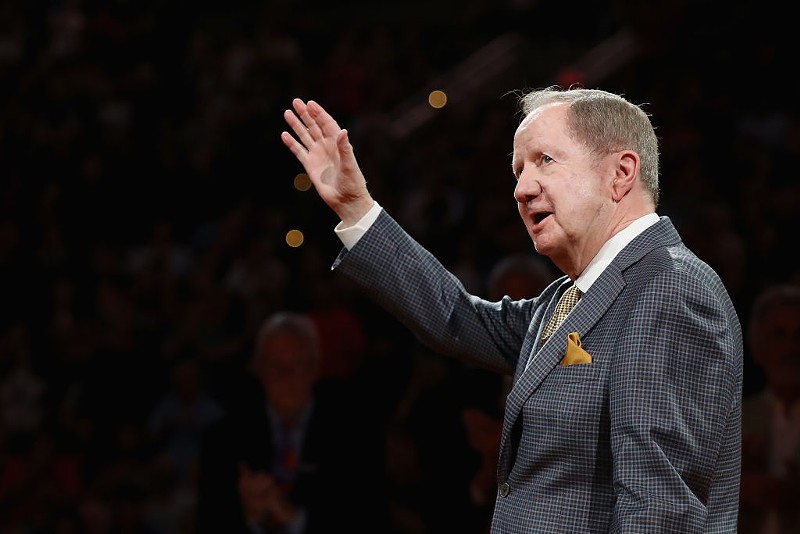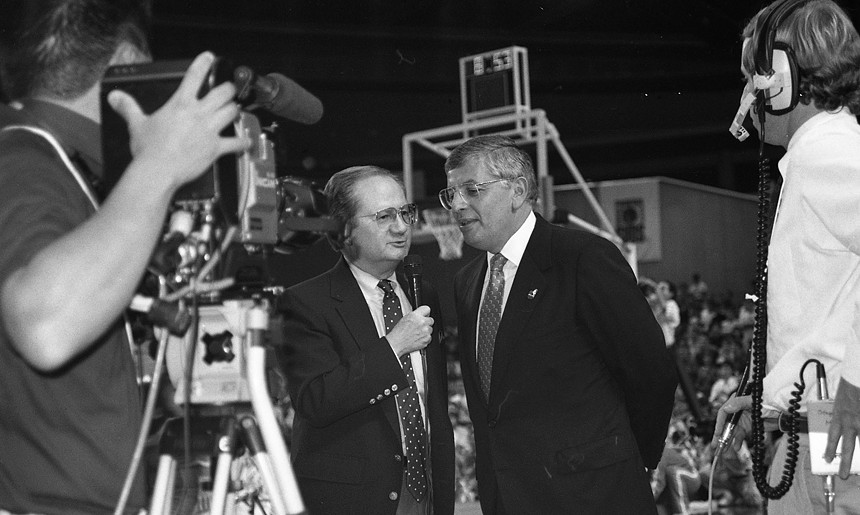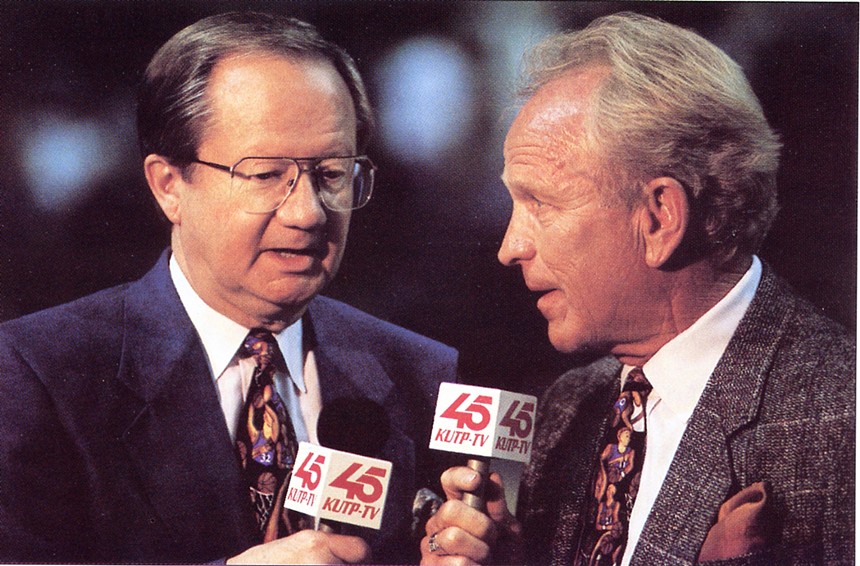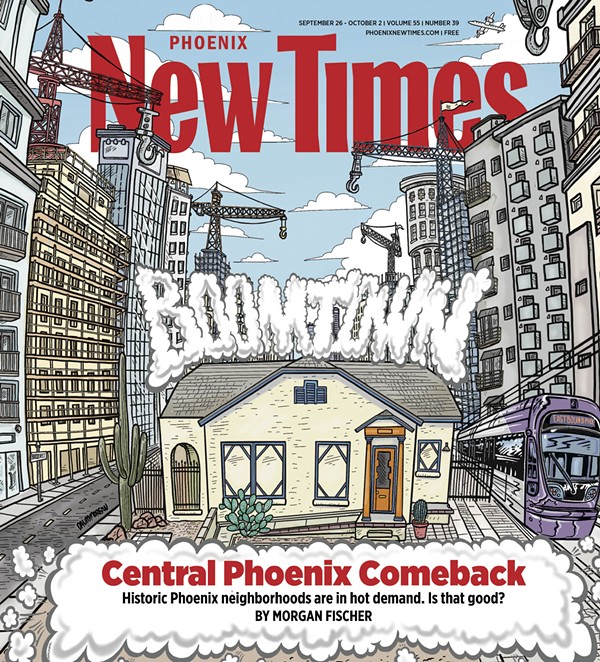A familiar friend’s booming baritone was always there, as sensational and consistent as our sunsets.
All-Stars and fan favorites came and went from the Valley sports scene for decades, but no figure has been as widely beloved as Al McCoy. For 51 years, the “Voice of the Suns” forged a career with more breath and breadth than that of any play-by-play announcer in NBA history.
McCoy died at age 91 on Sept. 21, six days before the anniversary of when “a farm boy from Iowa” first hit play on a Suns soundtrack for generations.
“His peak lasted 51 years,” said Jon Bloom, a childhood Suns fan who succeeded McCoy in calling Suns games on the radio. “The voice never wavered. The most identifiable broadcasters are the ones you don’t need to see or hear more than a couple words, and you know who they are. That’s Al McCoy.”
Oh, brother, is that ever true.
Through multiple on-air partners, various arena vantage points and 385 Suns players, McCoy was an authentic icon. His words brushed a basketball picture that left nothing to the fans’ imagination. He joined their eyes with a television simulcast until 2003 and remained their eyes on the radio until his final game in the 2023 playoffs.
“That confidence, steadiness and accuracy is everything you have to have in a broadcaster,” Tom Leander said. Leander began his Suns career as a ball boy in the mid-1970s, responsible for setting up McCoy’s courtside spot. He later became a Suns broadcast employee for 31 years, nine of which were spent following McCoy as the team’s television play-by-play announcer.
“You throw in the creativity, the catchphrases, his enthusiasm and that delivery, and he would always rise to the occasion,” Leander reminisced. “I never heard him blow a call. He was always ready for the moment and gave the perfect description. That’s why there are so many iconic calls on file. He nailed it every time.”
‘Shazam!’
McCoy stood only 5-foot-6 in an NBA human forest, but he was a hoops giant nonetheless.He began crafting his legacy while sitting on the fence posts of his childhood farm in Williams, Iowa, calling imaginary games to pigs and cattle. With no electricity at home and armed only with a battery-powered radio, McCoy absorbed the staccato of boxing calls and the storytelling of baseball announcers such as Chicago Cubs radio voice Bert Wilson.
His love affair with basketball may have seemed like fate. When he was 15 years old McCoy attended his first NBA game in Waterloo, Iowa, between the Waterloo Hawks and Tri-Cities Blackhawks. While in college at Drake University, he took basketball coaching classes and met Chick Hearn, who later became the legendary voice of the Lakers. In 2016, McCoy passed Hearn for the title of the NBA’s longest-tenured play-by-play announcer.
But when McCoy and his wife, Georgia, drove to Phoenix in 1958, he had baseball in mind. He’d been hired as the first voice of the Phoenix Giants, San Francisco’s relocated Triple-A club. The next 14 years were a grab bag of sports experiences. McCoy had two stints on the Giants and called six years of Arizona State football and basketball. He dabbled in Phoenix Madison Square Garden boxing and Phoenix Roadrunners hockey and worked as a rock radio disc jockey.
His sped-up editing on a 1966 NBA preseason demo tape helped convince then-Suns general manager Jerry Colangelo to hand him the franchise headset in 1972, landing him the job of a literal lifetime. Before long, Colangelo regarded McCoy as the team’s best salesman, helping the franchise spur Phoenix’s transformation into a major market.
An expanding fan base grew attached to McCoy’s vivacious voice repeating catchy calls. There was “Wham-bam-slam”; “Zing go the strings,” “Swisheroo for two” and “Twine time”; “Heartbreak Hotel” and “Put this one in the ol’ deep freeze.”
With the advent of the three-point shot, he added his iconic “Shazam,” but only when the Suns sank a trey.
McCoy narrated seasons to Suns supporters riding a never-ending franchise rollercoaster. He welcomed them at least 82 nights a year to a game they might not be able to afford to attend or could not watch with “wherever you are, whatever you’re doing.”
Former Diamondbacks broadcaster Greg Schulte, revered in his own right for a 26-year run on the radio, said, “They got rid of the mold when Al came around.” Schulte spent 17 years with McCoy as his producer, engineer and halftime/postgame host, including two years as McCoy's Suns analyst. The carpool buddies were Midwest transplants who became local legends and best friends with weekly talks and lovely memories.
“When he got excited or there were big moments in ball games, Al would grab my right arm with his left hand,” Schulte recalled. “I think he wanted to make sure he stayed in his seat. He wanted to control himself. He took moments that could be grand and made them grand.”
McCoy never stopped astonishing colleagues with the recall ability of a history professor, weaving anecdotes seamlessly into relatable live-game moments. His attention to detail was so precise that Leander sat at his boyhood bedroom desk listening to McCoy’s call, keeping statistics off the legend’s recounting.
Bloom caught the final 16 years of McCoy’s career, serving as a Suns pregame and postgame host before sharing play-by-play duties with McCoy. Even in his 80s, McCoy set an impossible standard. His superpower was staying power, avoiding off-nights unlike the best of players.
“It was downright flabbergasting and, in some cases, infuriating because most humans can’t be that consistent at something,” Bloom said. “To do it at the rate he did and be as good as he was when he was calling it a career is just dumbfounding.”
‘Meant to do what he did’
The NBA grind is taxing, with clubs hopscotching East Coast cities for a week or more. McCoy played sick on many occasions. Once before a game, an ill MCoy astonished then-radio partner Eddie Johnson by warning him he might have to take over play-by-play duties.Instead, McCoy delivered a Michael Jordan flu game.
“This dude not only called the game, but he did it like it was the seventh game of the NBA Finals,” said Johnson, a former player who has been a Suns broadcast analyst since 2003. “It truly blew me away. It meant that much to him. For the life of me, I don’t know how he did it that long.”
Johnson is one of the most prolific scorers in NBA history with 19,202 career points. But like most of McCoy’s analysts over 51 years, he was making a career transition to McCoy’s area of expertise.
McCoy became a sideline conductor, pointing at partners to cue them to talk in a rhythmic duet. Perhaps it was because McCoy also was an accomplished jazz pianist who commandeered hotel bar pianos, held court on the keys at the former Gaslight Inn near his Glendale home and donated his Suns Ring of Honor piano gift to The Nash jazz club in downtown Phoenix.
But although he played professional gigs after college, he kept a piece of that Williams High School point guard in his work. Over the years, the Valley treasure proved more adaptable to the game’s changes than a post-up center.
“I think about how he approached the game, and he was like a professional athlete, so to speak,” Johnson said. “It was amazing how he was able to persevere, especially at a later age. To do what he did, I’m so appreciative that he performed like he did. He was meant to do what he did.”
McCoy’s joy for his job remained when the headset was off. He was a loyal friend to those who knew him well and a kind person to those who only felt as though they did. Fans flocked nightly for a photo, an autograph or a word about how much he meant to them. In turn, he thanked them in his 2023 farewell for allowing him to bring the story of the Suns to their lives.
Each fan left an encounter with a genuine greeting, as if it was McCoy's first compliment. “The Real McCoy,” as his autobiography was titled, genuinely shared their passion and frustration for a franchise that sized him for its Ring of Honor rather than a championship ring.
“He was like the rest of us,” Leander said. “We are dying for a ring. But to me, it wasn’t about winning a ring for Al. It was the purpose, the goal and the interaction with fellow broadcasters, coaches, players and fans.”
In 2007, that purpose earned McCoy his field’s greatest honor, the Naismith Basketball Hall of Fame’s Curt Gowdy Media Award. When he lost his wife in 2012, his passion for career kept him going. At his final public appearance in May, McCoy helped introduce new Suns coach Mike Budenholzer, who grew up listening to McCoy with his family in their Holbrook living room. Budenholzer bowed to him.
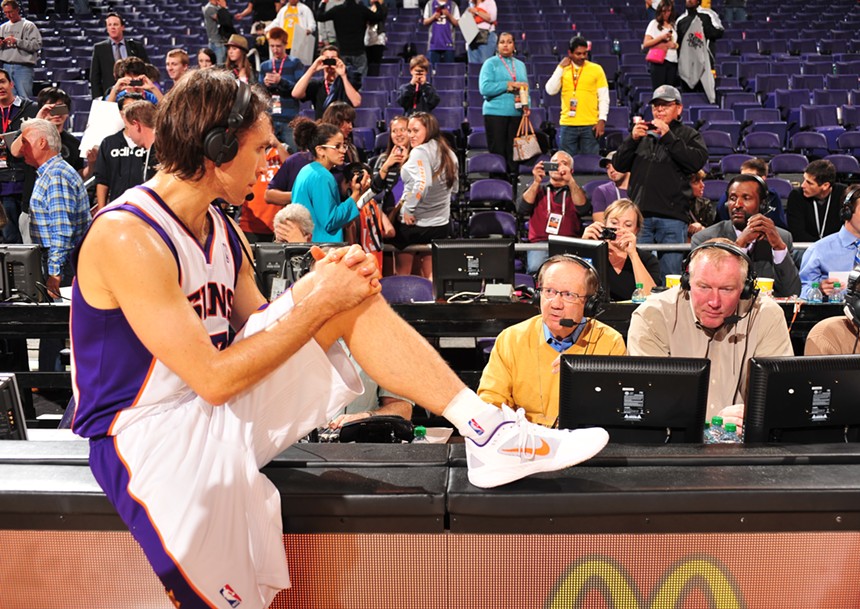
Phoenix Suns legend Steve Nash called Al McCoy "the teammate that never wore a jersey."
Phoenix Suns
The legend lives on
McCoy’s etched lexicon has outlived him, used recently in posthumous tribute calls by Arizona Cardinals announcer Dave Pasch and Arizona Diamondbacks announcer Chris Garagiola. Fans frequently demand that a McCoy be remembered with a statue in front of Footprint Center, just as Hearn was honored in Los Angeles. Such immortality would be only fitting.McCoy held the key to Phoenix, unlocking joy and nostalgia with how his calls brought a comforting distraction or a welcomed update. He inspired driveway hoop mimics, connected generations over mutual memories and groused about officials for fans in absentia.
Just like fans were, McCoy was crushed when Chicago Bulls guard John Paxson sank a game-winning shot to down the Suns in the 1993 Finals. He was outraged when San Antonio’s Robert Horry delivered a history-shifting hip check into Steve Nash, who called McCoy “the teammate that never wore a jersey.”
McCoy’s calls elevated Charles Barkley’s 45-point, 24-rebound playoff performance and Devin Booker’s 70-point game. But it’s his call of Gar Heard’s “The Shot Heard Round the World” in the 1976 Finals that lives on in legend.
Near midnight that night, just as Heard lofted a buzzer-beater to send Game 5 to overtime, a drunk Celtics fan passed out in McCoy’s lap. In just his fourth year on the headset, the future icon was unfazed.
“Here’s the jump shot … good!” McCoy said, shoving the fan off him to complete a call that now adorns a pillar at the Al McCoy Media Center. “It’s good! It counts! Gar Heard ties it! I want to tell you something. Somebody up there is on our side.”
Now, someone truly is.

